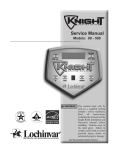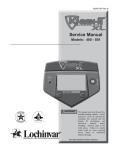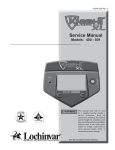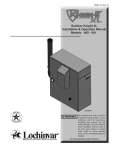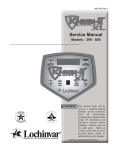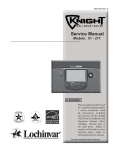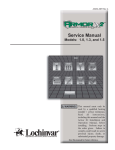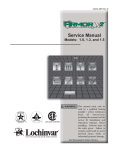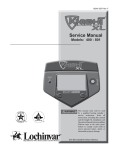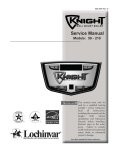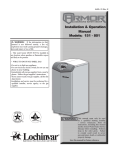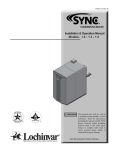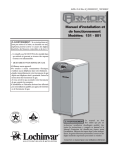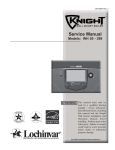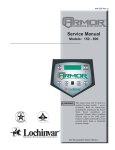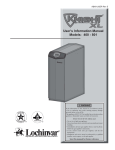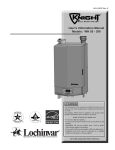Download continued - Lochinvar
Transcript
AWII-SER Rev E Service Manual Models: 151 - 801 WARNING LOW LEAD CONTENT This manual must only be used by a qualified heating installer / service technician. Read all instructions, including this manual and the Armor Water Heater Installation and Operation Manual, before installing. Perform steps in the order given. Failure to comply could result in severe personal injury, death, or substantial property damage. Save this manual for future reference. Contents CONTENTS........................................................................ 2 Hazard Definitions .............................................................. 2 PLEASE READ BEFORE PROCEEDING ........................ 3 Handling Ceramic Fiber Materials ...................................... 3 When servicing water heater ........................................ 3 Water heater operation ................................................ 3 WHAT IS IN THIS MANUAL ............................................. 4 1. SERVICE The Armor Water Heater Display ....................................... 5 Control Inputs ............................................................... 6 Control Outputs............................................................. 7 General Operation ........................................................ 8 Sequence of Operation ...................................................... 9 Display Panel Menu Access ............................................ 10 Display Panel Parameter Access ..................................... 11 Parameter Table.......................................................... 12-13 Viewable and Changeable Control Parameters .......... 14-18 2. MAINTENANCE Maintenance and Annual Startup ................................ 19-23 3. TROUBLESHOOTING Before Troubleshooting .................................................... 24 Check Control Module Fuses .......................................... 24 Table 3A - Troubleshooting Chart - No Display ............... 25 Checking Temperature Sensors ...................................... 26 Table 3E - Troubleshooting Chart - Noisy System .......... 27 Table 3F - Troubleshooting Chart - Fault Messages .. 28-35 Combustion Analysis Procedure ...................................... 36 Table 3G - Flue Products ................................................. 36 Table 3H - Troubleshooting Chart - Combustion Levels.. 36 Gas Valve Adjustment Procedure ............................... 37-38 Revision Notes .................................................. Back Cover Hazard definitions The following defined terms are used throughout this manual to bring attention to the presence of hazards of various risk levels or to important information concerning the life of the product. DANGER DANGER indicates an imminently hazardous situation which, if not avoided, will result in death or serious injury. WARNING indicates a potentially hazardous situation which, if not avoided, could result in death or serious WARNING injury. CAUTION indicates a potentially hazardous situation which, if not avoided, may result in minor or moderate CAUTION injury. CAUTION CAUTION used without the safety alert symbol indicates a potentially hazardous situation which, if not avoided, may result in property damage. NOTICE NOTICE indicates special instructions on installation, operation, or maintenance that are important but not related to personal injury or property damage. 2 Service Manual Please read before proceeding WARNING Installer – Read all instructions, including this manual and the Armor Water Heater Installation and Operation Manual, before installing. Perform steps in the order given. NOTICE Have this water heater serviced/inspected by a qualified service technician at least annually. Failure to comply with the above could result in severe personal injury, death or substantial property damage. Handling ceramic fiber materials REMOVAL OF COMBUSTION CHAMBER LINING WARNING The combustion chamber insulation in this appliance contains ceramic fiber material. Ceramic fibers can be converted to cristobalite in very high temperature applications. The International Agency for Research on Cancer (IARC) has concluded, “Crystalline silica in the form of quartz or cristobalite from occupational sources is carcinogenic to humans (Group 1)”. Normal operating temperatures in this appliance are below the level to convert ceramic fibers to cristobalite. Abnormal operating conditions would have to be created to convert the ceramic fibers in this appliance to cristobalite. The ceramic fiber material used in this appliance is an irritant; when handling or replacing the ceramic materials it is advisable that the installer follow these safety guidelines. Avoid breathing dust and contact with skin and eyes. • Use NIOSH certified dust respirator (N95). This type of respirator is based on the OSHA requirements for cristobalite at the time this document was written. Other types of respirators may be needed depending on the job site conditions. Current NIOSH recommendations can be found on the NIOSH website at http://www.cdc.gov/niosh/homepage.html. NIOSH approved respirators, manufacturers, and phone numbers are also listed on this website. When calling or writing about the water heater – Please have the water heater model and serial number from the water heater rating plate. Consider piping and installation when determining water heater location (see the Armor Water Heater Installation and Operation Manual). Any claims for damage or shortage in shipment must be filed immediately against the transportation company by the consignee. When servicing water heater – • To avoid electric shock, disconnect electrical supply before performing maintenance. • To avoid severe burns, allow the water heater to cool before performing maintenance. Water heater operation – • Do not block flow of combustion or ventilation air to the water heater. • Should overheating occur or gas supply fail to shut off, do not turn off or disconnect electrical supply to circulator. Instead, shut off the gas supply at a location external to the appliance. • Do not use this water heater if any part has been under water. The possible damage to a flooded appliance can be extensive and present numerous safety hazards. Any appliance that has been under water must be replaced. • Wear long-sleeved, loose fitting clothing, gloves, and eye protection. Apply enough water to the combustion chamber lining to prevent airborne dust. Remove the combustion chamber lining from the water heater and place it in a plastic bag for disposal. Wash potentially contaminated clothes separately from other clothing. Rinse clothes washer thoroughly. NIOSH stated First Aid. Eye: Irrigate immediately. Breathing: Fresh air. 3 Service Manual What is in this manual? Service Maintenance The Armor water heater display • Display panel readout, buttons and their functions Control module inputs • Control module inputs and options Control module outputs • Control module outputs and options General • How the water heater operates • How the control module operates • Access modes -- user and installer • Sequence of operation -- Water Heating Control panel menu access • Accessing programming mode and locating (See separate guide covering the PC interface.) menus Control panel parameter access • Service and maintenance schedules • Address reported problems • Inspect water heater area and water heater interior • Clean condensate trap • Check all piping for leaks • Check air openings • Flue vent system and air piping • Check water system • Check water heater relief valve • Inspect ignition electrode • Check ignition ground wiring • Check all water heater wiring • Check control settings • Perform start-up and checks • Check burner flame • Check flame signal • Check flue gas temperature • General maintenance • Review with owner • Cleaning the water heater heat exchanger • Oiled bearing circulators • Accessing and changing parameters from the display panel Troubleshooting Quick start information -- parameter table • • • • • An index of available adjustments and readouts, where to access them and where to find detailed information. Armor water heater operation • General • Data Logging • Functions • DHW Settings • Anti-Cycling • Control Modes • Circulation Pumps • BMS • Service Notification 4 Troubleshooting table - No display Checking temperature sensors Sensor tables Troubleshooting table - Fault messages displayed on the water heater interface • Combustion analysis procedure • Gas valve adjustment procedure Service Manual 1 Service The Armor water heater display NAVIGATION DIAL (PRESS OR TURN) RESET KEY LEFT SELECT KEY (SOFT KEY) RIGHT SELECT KEY (SOFT KEY) The information on the bottom of the display shows the functions of the two SELECT keys (on either corner), and the NAVIGATION dial (in the center): MENU = Left SELECT Key SETPOINTS = NAVIGATION Dial - Pressing Down SHDN = Right SELECT Key 5 Service Manual 1 Service Control inputs GAS PRESSURE SWITCH DHW THERMOSTAT FLOW SWITCH LOW VOLTAGE CONNECTION BOARD TANK SENSOR SEQUENCER / BUILDING MANAGEMENT SYSTEM LOW WATER CUTOFF O-TEMP HEAT EXCHANGER SWITCH INLET TEMPERATURE SENSOR OUTLET TEMPERATURE SENSOR FLUE GAS SENSOR AIR PRESSURE SWITCH LOUVER PROVING SWITCH FLAME SENSOR BLOCKED DRAIN SWITCH DISPLAY PANEL PC INTERFACE 6 SMART SYSTEM CONTROL BOARD Service Manual 1 Service (continued) Control outputs ALARM BELL LOW VOLTAGE CONNECTION BOARD LOUVER RELAY RUN TIME CONTACTS SEQUENCER / BUILDING MANAGEMENT SYSTEM BUILDING RECIRCULATION PUMP WATER HEATER PUMP IGNITOR BLOWER SMART SYSTEM CONTROL BOARD GAS VALVE DISPLAY PANEL PC INTERFACE 7 Service Manual 1 Service General Operation How the water heater operates The Armor water heater uses an advanced stainless steel heat exchanger and an electronic control module that allows fully condensing operation. The blower pulls in gas and air and pushes flue products out of the water heater through the heat exchanger and flue piping. The control module regulates blower speed to control water heater firing rate. The gas valve senses the amount of air flowing into the water heater and allows only the right amount of gas to flow. Sequence of operation Table 1A shows control module normal sequences of operation for water heating operation. Access modes User The user can adjust tank target temperatures by pressing the NAVIGATION dial when “SETPOINTS” is flashing at the bottom of the display. The date and time, and the temperature units can also be changed. Installer Most parameters are available only to the installer, accessible by entering the installer password (5309). Saving parameters (reference the Parameter Table Table 1D on pages 12 and 13 of this manual) NOTICE Please note that the brackets ([]) denote screen status. To save parameters and exit programming: Press the RIGHT SELECT [SAVE] key and then press the RIGHT SELECT [HOME] key. To enter a parameter and continue programming: Press the RIGHT SELECT [SAVE] key 1 time to return to the parameter listings; press again to return to the menu listings. Remember to press the RIGHT SELECT [HOME] key when finished programming in order to save the changes made. 8 Service Manual 1 Service (continued) Table 1A Sequence of operation OPERATION DISPLAY 1. The control will turn on the water heater pump (always ON except in Night Setback). The flow switch and/or LWCO must close. 2. The control turns on power to the louver relay. The louver proving switch, air pressure switch, and blocked drain switch must close. 3. The control starts the prepurge cycle. 4. The control starts the trial for ignition by firing the spark electrode and opening the gas valve. 5. If flame is not detected after the sparking ends, the control will perform a postpurge, then start another prepurge cycle and try to light the burner again. On the 501 and larger models, the control will lock out if this second attempt also fails. On the 400 and smaller models, the control will perform a total of 4 attempts before locking out. 6. If flame is detected, it holds the firing rate steady for a few seconds to let the flame stabilize, then it begins to modulate the firing rate based on a set point or some other command (such as a 0-10V BMS signal). 7. Once the call for heat is satisfied, the control will turn off the burner. The blower will continue to run during the postpurge period. 8. The water heater pump will continue to run for its respective pump delay time before turning off. A 60 second anti-cycle period will start, which will delay any new call for heat until it times out. 9. In Standby, ready to start a new cycle. 9 Service Manual 1 Service Display panel menu access Table 1B Use this procedure to access menus from the display panel BUTTON SCREEN STATUS [SHDN] [YES] [MENU] OPERATION Press the RIGHT SELECT soft key [SHDN]. Press the LEFT SELECT soft key [YES]. Press and hold the LEFT SELECT soft key [MENU] for five (5) seconds. Rotate the NAVIGATION dial clockwise until 5 is displayed (first digit on the left). Press the NAVIGATION dial to select the next digit. Rotate the NAVIGATION dial clockwise until 3 is shown in the display. Press the NAVIGATION dial 2 times to move to the last digit. Rotate the NAVIGATION dial counterclockwise until 9 is displayed. [SAVE] Press the RIGHT SELECT soft key [SAVE]. Rotate the NAVIGATION dial counterclockwise to select a category. 10 DISPLAY Service Manual 1 Service (continued) Display panel parameter access Table 1C This is a typical example of accessing a parameter, shown for parameter DHW Settings, TANK MIN Setpt BUTTON SCREEN STATUS OPERATION DISPLAY This example shows how to access parameter Temperature Settings. The first display shown is at the beginning of the menu listings, after entering the installer access code. Rotate the NAVIGATION dial counterclockwise until the arrow (>) is next to DHW SETTINGS. Press the NAVIGATION dial one time. Rotate the NAVIGATION dial counterclockwise until the arrow (>) is next to TANK MIN SETPT. Press the NAVIGATION dial one time. > > Rotate the NAVIGATION dial to the desired temperature. [SAVE] Press the RIGHT SELECT soft key [SAVE] one time. [EXIT] Press the LEFT SELECT soft key [EXIT] if all desired changes have been made. [HOME] > Press the LEFT SELECT soft key [HOME]. 11 Service Manual 1 Service Parameter table Table 1D This table lists SMART SYSTEM control module parameters and where to access them ANTICYCLING DHW SETTINGS FUNCTIONS DATA LOGGING GENERAL Menu 12 Description User Access See Page Display Modify Installer Access Display Modify Time and Date 14 Yes Yes Yes Yes Software Version (read only) 14 No No Yes No Temperature Units (ºC/ºF) 14 Yes Yes Yes Yes DHW Night Setback Offset 14 No No Yes Yes DHW Night Setback On Times 14 No No Yes Yes DHW Night Setback Off Times 14 No No Yes Yes Display Timeout 15 No No Yes Yes Reset Log Errors 15 No No Yes Yes Service Mode Delay 15 No No Yes Yes Tank Set Point 15 Yes Yes Yes Yes Tank Set Point Offset 15 Yes Yes Yes Yes Tank Set Point Differential 15 No No Yes Yes Tank Minimum Set Point 15 No No Yes Yes Tank Maximum Set Point 15 No No Yes Yes Anti-Cycling Time 15 No No Yes Yes Anti-Cycling Override Differential 15 No No Yes Yes Service Manual 1 Service (continued) Parameter table Table 1D (continued from previous page) This table lists SMART SYSTEM control module parameters and where to access them SERVICE NOTIFICATION BMS CIRCULATION PUMPS CONTROL MODES Menu Description User Access See Page Display Modify Installer Access Display Modify BMS Tstat Input 16 No No Yes Yes BMS 16 No No Yes Yes ModBus 16 No No Yes Yes ModBus T/O 16 No No Yes Yes Cascade Address 16 No No Yes Yes Cascade Type 16 No No Yes Yes Max Cascade Set Point 17 No No Yes Yes Min On/Off Time 17 No No Yes Yes Min Next On Time 17 No No Yes Yes Boiler Size 17 No No Yes Yes DHW Pump Delay 17 No No Yes Yes DHW Pump Anti-Seize Delay 17 No No Yes Yes BMS Type (Power / Set Point) 17 No No Yes Yes Volts at Min 17 No No Yes Yes Volts at Max 17 No No Yes Yes Rate at Min Volts 17 No No Yes Yes Rate at Max Volts 18 No No Yes Yes Set Point at Min Volts 18 No No Yes Yes Set Point at Max Volts 18 No No Yes Yes On Volts 18 No No Yes Yes Off Differential Volts 18 No No Yes Yes Service Notification Months 18 No No Yes Yes Service Notification Running Time 18 No No Yes Yes Service Notification Cycles 18 No No Yes Yes Reset Maintenance Reminder 18 No No Yes Yes Installer Name and Phone Number 18 No No Yes Yes 13 Service Manual 1 Service Viewable and changeable control parameters CAUTION Before changing parameters, note the settings so that the unit can be returned to its original operating parameters. General Time and Date The control uses an internal clock for the night setback feature and for logging of events. For these features to work correctly, the clock must be set when the water heater is first installed or anytime the water heater has been powered off for more than four (4) hours. This parameter must be accessed to set the clock. NOTICE Domestic Hot Water (DHW) Night Setback On Times This is the time in which the Night Setback Offset becomes active. There are 7 start times and 7 stop times each for the DHW night setback feature. The DHW Night Setback On Times may be set to any time within a 7-day week. These settings are referred to as triggers. Multiple start or stop triggers may be set within a single day, if desired. When a start trigger and a stop trigger are set to the same time, the stop trigger has priority. The installer may adjust the DHW start triggers in the DHW Night Setback On Times parameter. This screen shows the start trigger number, the day of the week, and the time of day. The internal clock does not adjust for Daylight Savings Time and therefore, will require a manual adjustment. The clock is automatically updated whenever a PC is connected and the Win_Pro-Installer program is started. NOTICE 1. Software Version The software version allows the user to view the software version in use by the control. This software controls the operation of the water heater. When a new software version becomes available, the existing control can be replaced with a new control to update the software. 2. Software version is read only. 3. Temperature units (°C / °F) The control can be configured to display temperature in either °C or °F. This parameter can be changed by the user or the installer by accessing the Temperature Units parameter. The default is °F. Domestic Hot Water (DHW) Night Setback Offset Once the unit’s internal clock has been set correctly, the Night Setback feature can be used to program a lower set point during unoccupied times. The DHW can be programmed for night setback. When in night setback, the control reduces the set point by a fixed amount. For DHW, it subtracts the DHW night setback offset from the tank set point (Tank Set point parameter). NOTE: The DHW night setback will not work without a tank sensor installed. The installer may adjust the DHW night setback offset by accessing the DHW Night Setback Offset parameter. The minimum setting is 0°F (0°C) and the maximum setting is 90°F (50°C). 14 4. Please note that the brackets ([]) denote screen status. When the screen is first accessed, start trigger number 1 is shown. If a different trigger number is desired, the installer can rotate the NAVIGATION dial until the desired trigger number is displayed. Once the desired trigger number is selected, the installer can press the NAVIGATION dial and the day of the week will start to flash. The installer can adjust the day of the week to the one he wishes to set. Once the day is set, the installer can press the NAVIGATION dial and the hour will begin to flash. After setting the hour, the installer can press the NAVIGATION dial and the minutes will flash. Once all settings have been made, the installer can press the RIGHT SELECT [SAVE] key. The installer can now select a different trigger and adjust the settings for that trigger. Once all adjustments are made, the installer can press the RIGHT SELECT [SAVE] key to save all of the new settings and return to the General menu, or press the LEFT SELECT [EXIT] key to return to the General menu without saving the changes. Domestic Hot Water (DHW) Night Setback Off Times The stop triggers for the DHW night setback feature can be adjusted by accessing DHW Night Setback Off Times parameter. Night Setback Override Any Night Setback On trigger currently active or scheduled within the next seven (7) days can be skipped. To skip a trigger, rotate the NAVIGATION dial until the arrow (>) is next to the trigger you wish to skip. Press the NAVIGATION dial once. “SK” will appear next to that trigger to indicate that it will be skipped. You can restore an upcoming trigger by selecting that trigger, and pressing the NAVIGATION dial again. The “SK” next to that trigger will disappear. Service Manual 1 Service (continued) To save any changes and return to the Home Screen, press the Tank Minimum Set Point RIGHT SELECT [HOME] key. To return to the Status Screen without saving the changes, press the LEFT SELECT [EXIT] key. This setting controls the minimum tank set point for the tank temperature. The installer can adjust this by accessing the Tank Display Timeout Minimum Set point parameter. The minimum setting is 60°F (16°C) and the maximum setting is the maximum tank set point This is the time in which the display remains illuminated. The (Tank Maximum Set point parameter). The default value is 60° range is 10 seconds to 10 minutes. The default is 3 minutes. (16°C). Data Logging Tank Maximum Set Point Reset log errors The reset log errors function clears the last 10 errors log. This setting controls the maximum tank set point for the tank temperature. The installer can adjust this by accessing the Tank Maximum Set point parameter. The minimum setting is the Functions minimum tank set point (Tank Minimum Set point parameter) Service Mode Delay and the maximum setting is 190°F (88°C). The default value is By pressing the pin button on the front of the display for five 140°F (60°C). (5) seconds, the control will be placed in Service Mode. This will override all other heat demands. The Service Mode allows Anti-Cycling the installer to set the unit to any firing rate for the purpose of combustion analysis. The delay sets the length of time the water Anti-Cycling Time heater will stay in the Service Mode if no keys have been pressed Once a SH demand has been satisfied, a set amount of time must before going back to its original state. This parameter can only elapse before the control will respond to a new SH demand. The be changed by the installer by accessing the Service Mode Delay control will block the new heat demand and anti-cycling will parameter. The time range of this parameter is 1 to 10 minutes. be shown in the display until the time has elapsed or the water The default value is 10 minutes. temperature drops below the Anti-Cycling Override Differential parameter. This parameter can be changed by the installer by DHW Settings accessing the Anti-Cycling Time parameter. The time range for DHW Tank Set Point this parameter is 1 minute to 10 minutes. The default value is By installing a tank sensor, the SMART SYSTEM control can 1 minute. perform the tank thermostat function. The SMART SYSTEM control automatically detects the presence of this sensor, and generates a DHW call for heat when the tank temperature drops below the tank set point differential (Tank Set point Differential parameter), and finishes the call for heat when the tank temperature reaches tank set point + offset. This parameter can be changed by the installer by accessing the DHW Tank Set point parameter. The temperature range of this parameter tank minimum set point to tank maximum set point. The default value is 125°F (52°C). Tank Set Point Offset Anti-Cycling Override Differential The control will bypass the anti-cycling time if the inlet water temperature drops too much. The control will use the inlet water temperature the water heater was at when it shut off as the starting point. If the inlet temperature drops below the temperature parameter the control will abort anti-cycling and allow the water heater to fire. This parameter can be changed by the installer by accessing the Anti-Cycling Override Differential parameter. The temperature range of this parameter is 0°F (0°C) to 54°F (30°C). The default value is 10°F (6°C). The tank set point offset measures how far the actual temperature must go above the set point before the call for heat ends (the water heater will turn off). This parameter can be changed by the installer by accessing the Tank Set Point Offset parameter. The temperature range of this parameter is 0°F (0°C) to 10°F (30°C). The default value is 4°F (6°C). Tank Set Point Differential When a tank sensor is installed, the tank temperature must drop this amount below the tank set point (DHW Tank Set point parameter) before the water heater turns back on. The installer can adjust this setting by accessing the Tank Set point Differential parameter. The minimum setting is 0° (0°C), and the maximum is 40°F (22°C). The default setting is 6°F (3°C). 15 Service Manual 1 Service Control modes Cascade Address BMS Thermostat Input The water heater designated as the Leader needs to be programmed with address 0. All the Member water heaters require addresses from 1 to 7, and the addresses must be different for each Member. The addresses can be in any order, regardless of the order in which the units are wired together. This parameter is adjustable by the installer by accessing the Cascade Address parameter. The tank sensor must be connected to the Leader water heater. The default address is 1. When controlling the water heater through the 0 - 10V BMS input or through ModBus, the water heater can be enabled one of two ways. With the BMS Thermostat Input parameter set to ACTIVE, the water heater will be enabled by closing the Heat/Loop Demand 1 input. When set to INACTIVE, the water heater will be enabled by the voltage level on the 0 - 10V input (in the case of 0 - 10V BMS control), or the 0 - 10V input value received through ModBus. The default value is INACTIVE. BMS The set point or modulation of the water heater may be controlled through the 0 - 10V BMS input or through ModBus. When the BMS parameter is set to INACTIVE, the 0 - 10V input will be ignored. When set to ACTIVE, the set point or modulation will be controlled by the voltage on the 0 - 10V input (in the case of 0 - 10V BMS control), or the 0 - 10V input value received through ModBus. The default value is INACTIVE. ModBus When BMS is set to ACTIVE (see BMS) and the water heater is being controlled through ModBus, set ModBus parameter to ACTIVE. Otherwise, set the ModBus parameter to INACTIVE. Note that the water heater can still be monitored by ModBus with this parameter set to INACTIVE. The default value is INACTIVE. ModBus T/O The ModBus T/O is the amount of time the unit controls will wait to receive a communication string from the BMS controller before reverting back to its own internal parameters. This parameter is adjustable by the installer by accessing the ModBus T/O parameter. The adjustment range of this parameter is 5 seconds to 2 minutes. The default value is 10 seconds. Cascade Type There are two (2) options for the way a Cascade divides the load between its heaters. The first is Lead/Lag, designated as L/L in the menu. This method is used when it is desired to have the least amount of total flow through the water heaters. This method will modulate the last two (2) water heaters. This provides for smooth transitions when a water heater turns on or off. When the last water heater reaches 100% and the calculated load is still increasing, it will start the next water heater at 20% and reduce the previous water heater to 80%, thus eliminating the sudden jump in total output of the Cascade. When the calculated load is decreasing and the last water heater gets down to 20% fire, it will hold it there and start lowering the firing rate on the next-to-last water heater. When the next-to-last water heater reaches 20%, it will turn the last water heater off and raise the rate of the next-to-last water heater to 40%, thus eliminating the sudden drop in total output of the Cascade. The other Cascade divider method is Efficiency Optimization, designated as EFF in the menu. This method is used, as the name implies, when it is desired to have the most efficient system. When the first water heater reaches a certain rate (default = 90%), it lowers its rate to 45% and turns on the next water heater at 45%. The two (2) water heaters then modulate at the same rate. As the calculated load increases further and both water heaters ramp up to 90%, it lowers the rate of the first two (2) water heaters to 60% and brings the next water heater on at 60%. The three (3) water heaters then modulate together. As the calculated load decreases, the water heaters will reach a lower threshold (default = 30%), at which time the last water heater (the third in our example) will turn off and the Cascade will increase the rates of the remaining water heaters to provide the equivalent total output as before ((3 x 30%) / 2 = 45% in our example). Efficiency optimization is automatically selected when heaters of different sizes are programmed into the Leader water heataer (see Boiler Size on page 17). 16 Service Manual 1 Service (continued) Maximum Cascade Set Point This parameter determines the set point used by the individual water heaters in a Cascade. When a water heater is commanded to fire by the Leader water heater, it will attempt to achieve this temperature at its outlet. The Leader water heater will limit the modulation of the water heaters in order to hold the temperature at the tank sensor to the user set point. If any of the water heater outlet temperatures reach the maximum cascade set point, the water heater will then modulate down on its own in order to keep its outlet temperature within the maximum cascade set point. Therefore, this parameter can be used to limit the outlet temperatures of all the water heaters in a Cascade. This parameter is adjustable by the installer by accessing the Maximum Cascade Set Point parameter. The temperature range of this parameter is 32° (0°C) to 190°F (88°C). The default maximum cascade set point is 185°F (85°C). Circulation pumps Minimum On/Off Time BMS In order to prevent units in a Cascade from short cycling, this parameter defines the minimum ON and OFF time for each unit. The installer can adjust this time by accessing the Minimum On/Off Time parameter. The minimum setting is 0 seconds and the maximum setting is 10 minutes. The default is 30 seconds. Minimum Next On Time In order to reduce the risk of temperature overshoot with a Cascade, this parameter defines the minimum time delay from starting one unit until the next unit may be started. The installer can adjust this time delay by accessing the Minimum Next On Time parameter. The minimum setting is 0 minutes and the maximum setting is 10 minutes. The default is 60 seconds. Boiler Size When boilers of different sizes are connected together in a Cascade, the Leader boiler has to know the size of each boiler in that Cascade. The Boiler Size parameters allow the installer to program the sizes based on the Cascade address. This screen shows the Cascade address and the size of the boiler with that address (in BTU/hr): 1. When the Boiler Size screen is first accessed, Cascade Address 0 (Leader) is shown. 2. Press the NAVIGATION dial to access the first digit of the boiler size. Rotate the NAVIGATION dial to adjust the first digit. To access the next digit, press the NAVIGATION dial again. Continue this process until the correct boiler size (to the nearest 1000 BTU/hr) is shown. Press the RIGHT SELECT [SAVE] key. 3. Rotate the NAVIGATION dial to select the address of the next boiler in the Cascade. Repeat Step 2. 4. Once the size of the last boiler in the Cascade has been entered and saved, press the LEFT SELECT [EXIT] key to return to the Control Modes menu. 5. If no other parameters are to be adjusted, press the RIGHT SELECT [HOME] key to save the new settings and return to the Status screens. The SMART SYSTEM control automatically uses the Efficiency Optimization Cascade type when controlling boilers of different sizes. DHW Pump Delay The DHW pump delay parameter sets the length of time the DHW pump (if connected) will run after a DHW demand has been satisfied. This parameter is adjustable by the installer by accessing the DHW Pump Delay parameter. The time range for this parameter is 10 seconds to 40 minutes. The default time is 1 minute. DHW Pump Anti-Seize Delay If the water heater pump does not run for 24 hours, it will be turned on briefly to prevent it from seizing. The length of time it runs is determined by the DHW Pump Anti-Seize Delay parameter. The range of this setting is 0 seconds to 50 minutes. The default setting is 20 seconds. BMS Type When programmed for BMS control through the 0 - 10V BMS input or through ModBus, the 0 - 10V signal can be interpreted as either a modulation command or a set point. When the BMS Type parameter is set to POWER, the 0 - 10V signal will control the modulation. When set to SETPOINT, the 0 - 10V signal will control the tank set point. The default setting is SETPOINT. Volts at Minimum When programmed for BMS control through the 0 - 10V BMS input or through ModBus, the Volts at Minimum parameter should be set to the minimum voltage signal sent to the SMART SYSTEM control. The range of this parameter is 0.0V to the Volts at Maximum value. The default setting is 2.0V. Volts at Maximum When programmed for BMS control through the 0 - 10V BMS input or through ModBus, the Volts at Maximum parameter should be set to the maximum voltage signal sent to the SMART SYSTEM control. The range of this parameter is the Volts at Minimum value to 10.0V. The default value is 10.0V. Rate at Minimum Volts When programmed for BMS control through the 0 - 10V BMS input or through ModBus and the BMS Type is programmed as POWER, the modulation percentage represented by the Volts at Minimum parameter is set by the Rate at Minimum Volts parameter. The minimum value is 0% and the maximum is the Rate at Maximum Volts setting. The default value is 20%. 17 Service Manual 1 Service Rate at Maximum Volts When programmed for BMS control through the 0 10V BMS input or through ModBus and the BMS Type is programmed as POWER, the modulation percentage represented by the Volts at Maximum parameter is set by the Rate at Maximum Volts parameter. The minimum value is the Rate at Minimum Volts setting and the maximum is 100%. The default value is 100%. Set Point at Minimum Volts When programmed for BMS control through the 0 - 10V BMS input or through ModBus and the BMS Type is programmed as SETPOINT, the set point represented by the Volts at Minimum parameter is set by the Set Point at Maximum Volts parameter. The minimum value is 32°F (0°C) and the maximum is the Set Point at Maximum Volts setting. The default value is 70°F (21°C). Set Point at Maximum Volts When programmed for BMS control through the 0 - 10V BMS input or through ModBus and the BMS Type is programmed as SETPOINT, the set point represented by the Volts at Maximum parameter is set by the Set Point at Maximum Volts parameter. The minimum value is the Set Point at Minimum Volts setting and the maximum is 190°F (88°C). The default value is 180°F (82°C). On Volts When programmed for BMS control through the 0 - 10V BMS input or through ModBus and the BMS Thermostat Input is set to INACTIVE, the On Volts parameter determines the 0 - 10V BMS input voltage at which the water heater is enabled. The minimum value is 0.5V and the maximum is 10.0V. The default value is 2.0V. Off Differential Volts When programmed for BMS control through the 0 - 10V BMS input or through ModBus and the BMS Thermostat Input is set to INACTIVE, the Off Differential Volts parameter determines how far below the On Volts setting the 0 - 10V BMS input voltage must be in order to disable the water heater. The minimum value is 0.2V and the maximum is the On Volts setting. The default value is 1.0V. Service Notification This feature has been disabled by the manufacturer. To enable this feature change the Service Notification in Months parameter to the desired time range. Service Notification Running Time When the water heater control determines that a scheduled service is due based on the hours of actual operation, the water heater display will turn yellow and a new status screen will appear informing the installer that maintenance is required. This parameter is adjustable by the installer by accessing the Service Notification Running Time parameter. The time range for this parameter is 0 hours to 17,500 hours. The default time is 8,760 hours. Service Notification Cycles When the water heater control determines that a scheduled service is due based on the number of water heater cycles, the water heater display will alternate the standard water heater display text with the message SERVICE DUE every 5 seconds. This parameter is adjustable by the installer by accessing the Service Notification Cycles parameter. The range for this parameter is 0 cycles to 100,000 cycles. The default is 50,000 cycles. Reset Maintenance Reminder Once service has been completed, the service notification counter should be reset. This parameter can be reset by the installer by accessing the Reset Maintenance Reminder parameter. Once accessed, press the RESET key to reset the service notification counter. Installer Name and Phone Number NOTICE When a Maintenance Reminder timer or counter has expired, a Maintenance Reminder screen will appear on the display. By programming the installer’s name and phone number, this information will appear on the Maintenance Reminder Screen at that time. This can be programmed by accessing the Service Name and Phone Number parameter. When selected, another menu will appear with PHONE and NAME. 1. 2. Service Notification in Months When the water heater control determines that a scheduled service is due based on days of installation, the water heater display will alternate the standard water heater display text with the message SERVICE DUE every 5 seconds. This parameter is adjustable by the installer by accessing the Service Notification in Months parameter. The time range for this parameter is 0 months to 100 months. The default time is 12 months. 18 Please note that the brackets ([]) denote screen status. 3. 4. Rotate the NAVIGATION dial to point to the name/phone number to program and press the NAVIGATION dial. The screen will now display the selected item (either PHONE or NAME). Press the NAVIGATION dial again. A cursor will appear at the bottom of the screen. By rotating the NAVIGATION dial, various numbers and characters will appear. When the desired number/character is found, press the NAVIGATION dial. The cursor will move to the next position. Repeat this procedure until the entire message is entered. If you make a mistake and wish to back up one character, rotate the NAVIGATION dial until the back arrow () character is displayed and press the NAVIGATION dial. When finished, press the RIGHT SELECT [SAVE] key to return to the previous menu. Service Manual 2 Maintenance Maintenance and annual startup Table 2A Service and Maintenance Schedules Service technician (see the following pages for instructions) Owner maintenance General: • Address reported problems • Inspect interior; clean and vacuum if necessary; Daily • Check water heater area • Check pressure/temperature gauge • Clean condensate trap and fill with fresh water ANNUAL START-UP • Check for leaks (water, gas, flue, condensate) • Verify flue and air lines in good condition and sealed tight • Check system water pressure/system piping/expansion tank • Check vent piping • Check control settings • Check air piping • Check ignition and flame sense electrodes (sand off any deposits; clean and reposition) Monthly • Check air and vent termination screens • Check wiring and connections • Check relief valve • Perform start-up checkout and performance verification per Section 10 in the Armor Installation and Operation Manual. • Check condensate drain system • Check air vents • Check Delta T (Temperature Rise) • Flame inspection (stable, uniform) • Flame signal (at least 10 microamps at high fire) • Clean the heat exchanger if flue temperature is more than 54°F above return water temperature. • Check Delta T (Temperature Rise) If combustion indicate need: or performance Every 6 months • Check water heater piping (gas and water) for leaks • Operate relief valve • Clean heat exchanger • Remove and clean compressed air only burner using • Clean the blower wheel 19 Service Manual 2 Maintenance WARNING Follow the service and maintenance procedures given throughout this manual and in component literature shipped with the water heater. Failure to perform the service and maintenance could result in damage to the water heater or system. Failure to follow the directions in this manual and component literature could result in severe personal injury, death, or substantial property damage. WARNING The water heater should be inspected annually only by a qualified service technician. In addition, the maintenance and care of the water heater designated in Table 2A and explained on the following pages must be performed to assure maximum water heater efficiency and reliability. Failure to service and maintain the water heater and system could result in equipment failure. WARNING Electrical shock hazard – Turn off power to the water heater before any service operation on the water heater except as noted otherwise in this instruction manual. Failure to turn off electrical power could result in electrical shock, causing severe personal injury or death. Address reported problems Figure 2-1 Condensate Trap 1. Inspect any problems reported by the owner and correct before proceeding. RETAINING SCREW Inspect water heater area 2” PVC CAP WITH BLOCKED DRAIN SWITCH 1. Verify that water heater area is free of any combustible materials, gasoline and other flammable vapors and liquids. 2. Verify that air intake area is free of any of the contaminants listed in Section 1 of the Armor Water Heater Installation and Operation Manual. If any of these are present in the water heater intake air vicinity, they must be removed. If they cannot be removed, reinstall the air and vent lines per this manual and the Armor Water Heater Installation and Operation Manual. Inspect water heater interior 1. Remove the front access cover and inspect the interior of the water heater. PVC TEE ASSEMBLY (FACTORY SUPPLIED) CONDENSATE FROM HEAT EXCHANGER WARNING 2. Vacuum any sediment from inside the water heater and components. Remove any obstructions. Clean condensate trap 1. Inspect the condensate drain line, condensate PVC fittings, and condensate trap. TO FLOOR DRAIN The condensate trap must be filled with water during all times of water heater operation to avoid flue gas emission from the condensate drain line. Failure to fill the trap could result in severe personal injury or death. Check all piping for leaks WARNING Eliminate all system or water heater leaks. Leaking water may cause severe property damage. 2. Remove the PVC cap retaining screw from the PVC cap (FIG. 2-1). 1. Inspect all water and gas piping and verify to be leak free. 3. Remove the 2 inch PVC cap with the switch located at the top of the trap (FIG. 2-1). 2. Look for signs of leaking lines and correct any problems found. 4. Remove any sediment in the trap. 3. Check gas line using the procedure found in Section 7 Gas Connections of the Armor Water Heater Installation and Operation Manual. 5. Fill with fresh water until the water begins to pour out of the drain. 6. Replace the cap. Press the cap onto the trap until the cap makes contact with the drain. 7. Replace the retaining screw. 20 Service Manual 2 Maintenance (continued) Flue vent system and air piping 1. Visually inspect the entire flue gas venting system and air piping for blockage, deterioration or leakage. Repair any joints that show signs of leakage. Verify that air inlet pipe is connected and properly sealed. 2. Verify that water heater vent discharge and air intake are clean and free of obstructions. WARNING WARNING Safety relief valves should be re-inspected AT LEAST ONCE EVERY THREE YEARS, by a licensed plumbing contractor or authorized inspection agency, to ensure that the product has not been affected by corrosive water conditions and to ensure that the valve and discharge line have not been altered or tampered with illegally. Certain naturally occurring conditions may corrode the valve or its components over time, rendering the valve inoperative. Such conditions are not detectable unless the valve and its components are physically removed and inspected. This inspection must only be conducted by a plumbing contractor or authorized inspection agency – not by the owner. Failure to re-inspect the water heater relief valve as directed could result in unsafe pressure buildup, which can result in severe personal injury, death, or substantial property damage. WARNING Following installation, the valve lever must be operated AT LEAST ONCE A YEAR to ensure that waterways are clear. Certain naturally occurring mineral deposits may adhere to the valve, rendering it inoperative. When manually operating the lever, water will discharge and precautions must be taken to avoid contact with hot water and to avoid water damage. Before operating lever, check to see that a discharge line is connected to this valve directing the flow of hot water from the valve to a proper place of disposal. Otherwise severe personal injury may result. If no water flows, valve is inoperative. Shut down the water heater until a new relief valve has been installed. Failure to inspect for the above conditions and have them repaired can result in severe personal injury or death. Check water system 1. Verify all system components are correctly installed and operational. 2. Verify system pressure is at least 12 PSI. 3. Watch the system pressure as the water heater heats up (during testing) to ensure pressure does not rise too high. Excessive pressure rise indicates expansion tank sizing or performance problem. 4. Inspect automatic air vents and air separators. Remove air vent caps and briefly push valve to flush vent. Replace caps. Make sure vents do not leak. Replace any leaking vents. Check expansion tank 1. Expansion tanks provide space for water to move in and out as the water expands due to temperature increase or contracts as the water cools. Tanks may be diaphragm or bladder type. See Section 6 - System Piping of the Armor Water Heater Installation and Operation Manual for suggested best location of expansion tanks and air eliminators. Check water heater relief valve 1. Inspect the relief valve and lift the lever to verify flow. Before operating any relief valve, ensure that it is piped with its discharge in a safe area to avoid severe scald potential. Read Section 6 - System Piping of the Armor Water Heater Installation and Operation Manual before proceeding further. 2. After following the above warning directions, if the relief valve weeps or will not seat properly, replace the relief valve. Ensure that the reason for relief valve weeping is the valve and not over-pressurization of the system due to expansion tank waterlogging or undersizing. 21 Service Manual 2 Maintenance Inspect ignition and flame sense Check burner flame electrodes 1. Inspect flame through observation window. 1. Remove the ignition and flame sense electrodes from the water heater heat exchanger access cover. 2. Remove any deposits accumulated on the ignition/ flame sense electrode using sandpaper. If the electrodes cannot be cleaned satisfactorily, replace with new ones. 3. Replace ignition/flame sense electrode, making sure gasket is in good condition and correctly positioned. Check ignition ground wiring 1. Inspect water heater ground wire from the heat exchanger access cover to ground terminal strip. 2. If the flame is unsatisfactory at either high fire or low fire, turn off water heater and allow water heater to cool down. Remove the burner and clean it thoroughly using a vacuum cleaner or compressed air. Do not use compressed air to clean burner if performed inside a building. 3. Remove the burner, reference FIG. 2-2 below. 4. When replacing the burner, ensure gasket is in good condition and positioned correctly (FIG. 2-2). Figure 2-2 Burner Assembly 2. Verify all wiring is in good condition and securely attached. 3. Check ground continuity of wiring using continuity meter. 4. Replace ground wires if ground continuity is not satisfactory. Check all water heater wiring 1. Inspect all water heater wiring, making sure wires are in good condition and securely attached. Check control settings 1. Set the SMART SYSTEM control module display to Parameter Mode and check all settings. See Section 1 of this manual. Adjust settings if necessary. See Section 1 of this manual for adjustment procedures. 2. Check settings of external limit controls (if any) and adjust if necessary. Perform start-up and checks 1. Start water heater and perform checks and tests specified in Section 10 - Start-up of the Armor Water Heater Installation and Operation Manual. 2. Verify cold fill pressure is correct and that operating pressure does not go too high. 22 Check flame signal 1. At high fire the flame signal shown on the display should be at least 10 microamps. 2. A lower flame signal may indicate a fouled or damaged flame sense electrode. If cleaning the flame sense electrode does not improve, ground wiring is in good condition, and ground continuity is satisfactory, replace the flame sense electrode. 3. See Section 3 - Troubleshooting in this manual for other procedures to deal with low flame signal. Review with owner 1. Emphasize the need to perform the maintenance schedule specified in this manual. 2. Remind the owner of the need to call a licensed contractor should the water heater or system exhibit any unusual behavior. 3. Remind the owner to follow the proper shutdown procedure and to schedule an annual start-up at the beginning of the next heating season. Service Manual 2 Maintenance (continued) Cleaning heat exchanger For recommended materials; including brush, appropriate extension(s), refractory cover, and detailed instructions see Table 2B - Heat Exchanger Cleaning Kits. 1. Shut down water heater: • Follow the “To Turn Off Gas to Appliance” instructions for the water heater in Section 10 Startup of the Installation and Operation Manual. • Do not drain the water heater unless it will be exposed to freezing temperatures. If using freeze prevention fluid in system, do not drain. 2. Allow time for the water heater to cool to room temperature if it has been firing. 3. Remove the nuts securing the heat exchanger access cover to the heat exchanger and set aside. 4. Table 2B Heat Exchanger Cleaning Kits Model Kit Number 151 400 KIT30063 501 801 KIT30064 CAUTION Part Number CTN20005 Rear Refractory Cover MSC20083* Nylon 4" Wheel Brush* MSC20084 3mm Allen Wrench MSC20086 1/4" x 24" Drill Extension CTN20005 Rear Refractory Cover MSC20083* Nylon 4" Wheel Brush* MSC20085 MSC20086 1/4" x 12" Drill Extension 1/4" x 24" Drill Extension * Do NOT use a metal brush. Only use the kit provided brush or an equivalent replacement nylon brush. Figure 2-3 Rope Gasket - Heat Exchanger Door Remove the heat exchanger access cover, burner, and gas/air arm assembly. WARNING The water heater contains ceramic fiber materials. Use care when handling these materials per the instructions on page 3 of this manual. Failure to comply could result in severe personal injury. 5. Remove the condensate hose from the heat exchanger end. Connect a field supplied 3/4" diameter hose to a drain pan. Using field supplied means, cover the refractory in the back of the combustion chamber of the heat exchanger. 6. Use a vacuum cleaner to remove any accumulation on the water heater heating surfaces. Do not use any solvent. 7. Brush the heat exchanger while dry using a nylon bristle brush. Caution: DO NOT use a metal brush. Re-vacuum the heat exchanger. 8. Finish cleaning using a clean cloth dampened with warm water. Rinse out debris with a low pressure water supply. 9. Allow the heat exchanger to thoroughly dry. 10. Remove the field supplied rear refractory cover from the back of the combustion chamber of the heat exchanger and reassemble. 11. Close isolation valves on piping to isolate water heater from system. Attach a hose to the water heater drain and flush water heater thoroughly with clean water by using purging valves to allow water to flow through the water make-up line to the water heater. 12. Perform start-up and check-out procedures in the Check Flame and Combustion - Section 10 - Startup of the Installation and Operation Manual. 13. Replace the access cover and restore water heater to operation. Component Description ROPE GASKET CAUTION: IF GASKET IS DAMAGED DO NOT REUSE, THE HEAT EXCHANGER DOOR MUST BE REPLACED. NOTICE Rope gasket is intended for sealing combustion (see FIG. 2-3). If gasket is damaged DO NOT reuse, the heat exchanger door must be replaced. Consult factory for replacement heat exchanger door (kit WTR3080 and WTR3086). Check Delta T 1. Check the Delta T using Table 2C as a reference. Table 2C Water Heater Pump Applications / Recommended Temperature Rise Water Heater Pump Applications *Pipe Flow Rate Loss Temp. Model Armstrong Grundfos Size (GPM) (FT/HD) Rise 151 200 286 400 501 601 1-1/4" 1-1/4" 2" 2" 2" 2" E8 E8 E17 E24 E22 E22 ------- 16 21 30 39 53 53 16.6 11.8 17.1 21 26 26 18°F 18°F 18°F 18°F 18°F 22°F 701 2" -- TP 40-160 63 32 22°F 801 2" -- TP 40-160 67 31 24°F Oiled bearing circulators 1. The circulator shipped with the Armor water heater is waterlubricated. No oiling is required. 2. Check other circulators in the system. Oil any circulators requiring oil, following circulator manufacturer’s instructions. Over-oiling will damage the circulator. 23 Service Manual 3 Troubleshooting WARNING Label all wires prior to disconnection when servicing controls. Wiring errors can cause improper and dangerous operation. Always disconnect power to the water heater before servicing. Failure to comply could result in severe personal injury, death, or substantial property damage. Never jumper (bypass) any device WARNING except for momentary testing as outlined in the Troubleshooting chart. Severe personal injury, death, or substantial property damage can result. Before troubleshooting: Check control module fuses NOTICE ALWAYS check control module fuses before replacing control module or any major components (blower, etc.). If one of these fuses is blown, it can prevent the control module or other components from operating. 1. Turn OFF power to the water heater at the external line switch. 2. Remove top access cover. 3. Remove the control module cover. 4. Inspect fuses F1, F2 and F3, see FIG 3-1 below. Figure 3-1 Control Module Fuses 1. Have the following items: a. Voltmeter that can check 120 VAC, 24 VAC, and 12 VDC. b. Continuity checker. c. Contact thermometer. 2. Check for 120 VAC (minimum 102 VAC to maximum 132 VAC) to water heater. 3. Make sure thermostat is calling for heat and contacts (including appropriate zone controls) are closed. Check for 24 VAC between thermostat wire nuts and ground. 4. Make sure all external limit controls are installed and operating. Check the following: 1. Wire connectors to control module are securely plugged in at the module and originating control. 2. Gas pressures: • Maximum: 14 inches w.c. (natural and LP) with no flow (lockup) or with water heater on • Minimum: 4 inches w.c. (natural), 8 inches w.c. (LP) with gas flowing (verify during water heater startup) 24 F3 - .80 AMP FUSE 24V DC POWER SUPPLY F1 - 5 AMP FUSE PUMPS F2 - 3.15 AMP FUSE BLOWER 5. The water heater is shipped with three (3) spare fuses in a plastic bag attached to the control module cover. 6. If necessary, replace open fuse (F3 is .80 amps, F2 is 3.15 amps, and F1 is 5 amps). Note: Fuses F1, F2 and F3 are all slow blow fuses. WARNING Do not jumper fuse or replace with any fuse except as specified. Failure to comply could result in severe personal injury, death, or substantial property damage. 7. Install control module cover and top access cover after fuse inspection. 8. Restore power to the water heater at the external line switch and verify water heater operation (Section 10 - Start-up in the Armor Water Heater Installation and Operation Manual) after completing water heater service. Service Manual 3 Troubleshooting (continued) Table 3A Troubleshooting Chart - No Display FAULT CAUSE CORRECTIVE ACTION • Check external line switch, fuse, or breaker. • Check position of ON/OFF switch. Turn switch to the ON position. - No 120 VAC supplied to unit. • Check 120 VAC through the ON/OFF switch. • Check wiring harness connection between display board and main control board. Connect harness at both points. No Display - No voltage through the switch. • Replace switch. - Bad display board. • Replace board. - Bad main control board. • Replace the main control board. - Blown fuse. • Replace fuse F3 on the main control board, see page 24 of this manual. - Main control board temperature set point • Review temperature setting. satisfied. No Burner Operation - Remote thermostat satisfied. • Review remote thermostat setting. - Unit locked out on fault. • Consult display for specific fault. Refer to fault descriptions on pages 28 - 35 of this manual for corrective actions. - Water heater controlled by BMS. • Check BMS parameter settings. Optional PC software required. Unit Does Not Modulate Above 50% - Flue sensor open. • Verify that the flue sensor is located in the flue outlet. • Check wiring connections at the flue sensor. • Check the resistance of the flue sensor and compare to Table 3D on page 26 of this manual. 25 Service Manual 3 Troubleshooting Checking temperature sensors The water heater temperature sensors (inlet water, outlet water, system water, and flue) are all resistance type devices. The following tables show the correct values for the sensors at various temperatures. Use an ohmmeter to read the resistance of the sensor at a known temperature. If the resistance of the sensor does not closely match its corresponding table, replace the sensor. It is important to note that the flue and outlet water sensors have two temperature sensing devices in one housing. These devices are designated as S1a/S1b, outlet sensor and S3a/S3b, flue sensor. Please reference the wiring diagram in the Armor Water Heater Installation and Operation Manual for correct terminal location. Table 3B - Inlet System Sensor Resistance vs. Temperature Temperature °F Resistance Temperature °F Resistance 50 18,780 158 1,990 68 12,263 176 1,458 86 8,194 194 1,084 104 5,592 212 817 122 3,893 -- -- 140 2,760 -- -- Table 3C - Outlet Water Sensor Resistance vs. Temperature S1a S1b (Wire Color - R/BK and Y) (Wire Color - G and Y) Temperature Resistance Temperature Resistance Temperature Resistance Temperature Resistance 50 68 86 104 122 140 19,553 12,690 8,406 5,715 3,958 2,786 158 176 194 212 2,004 1,464 1,084 816 50 68 86 104 122 140 40,030 25,030 16,090 10,610 7,166 4,943 158 176 194 212 3,478 2,492 1,816 1,344 Table 3D - Flue Sensor Resistance vs. Temperature S3a S3b (Wire Color - W/B and Y) (Wire Color - PR and Y) Temperature Resistance Temperature Resistance Temperature Resistance Temperature Resistance 50 68 86 104 122 140 26 40,030 25,030 16,090 10,610 7,166 4,943 158 176 194 212 3,478 2,492 1,816 1,344 50 68 86 104 122 140 258,500 125,500 80,220 52,590 35,270 24,160 158 176 194 212 16,870 12,000 8,674 6,369 Service Manual 3 Troubleshooting (continued) Table 3E Troubleshooting Chart - Noisy System FAULT CAUSE CORRECTIVE ACTION - Supply gas problem. Natural gas pressures • Refer to Section 7 - Gas Connections of the Armor should be between 4 inches w.c. and 14 Water Heater Installation and Operation Manual for inches w.c. LP gas pressures should be detailed information concerning the gas supply. between 8 inches w.c. and 14 inches w.c. - Gas/air mixture problem. • Refer to the Gas Valve Adjustment Procedure on pages 37-38 of this manual for the proper gas valve setting. Verify that the vent/air intake lengths do not exceed the maximum listed in the General Venting section of the Armor Water Heater Installation and Operation Manual. - Dirty/damaged burner. • Refer to page 22 in this manual for the burner removal and inspection procedure. Clean or replace the burner as necessary. - Low water flow through the heat exchanger. • Refer to Section 6 - System Piping of the Armor Water Heater Installation and Operation Manual for minimum flow rates. - Air in the piping system. • Properly purge all air from the piping system. - Low system water pressure. • Verify system pressure is a minimum of 12 PSI. - Blown fuse. • Replace fuse F1 on the control board, see page 24 of this manual. - Faulty pump. • Replace pump. - Faulty pump relay. • Replace pump relay. - Internal fault on control board. • Replace main control board. Noisy Operation No Pump Operation Relief Valve Opening - System pressure exceeds relief valve • Lower the system pressure below the 150 PSI rating of setting. the supplied relief valve. 27 Service Manual 3 Troubleshooting Table 3F Troubleshooting Chart - Fault Messages Displayed on Water Heater Interface FAULT DESCRIPTION Gas Pressure SW (will require a manual reset once the condition has been corrected. Press Either the manual reset low gas pressure the RESET button on the switch or the manual reset high gas pressure SMART SYSTEM display switch tripped. to reset.) Flow Switch (will require a manual reset once condition has The flow switch is not making. been corrected. Press the RESET button on the SMART SYSTEM display to reset.) Blown fuse. Blocked Drain SW (will require a manual reset once condition has The blocked drain switch has detected been corrected. Press excessive condensate build up inside the the RESET button on the unit. SMART SYSTEM display to reset.) CORRECTIVE ACTION • Reset the pressure switches. • Measure the supply gas pressure to determine cause of failure. Natural gas pressures should be between 4 - 14 inches w.c. • Refer to Section 7 - Gas Connections of the Armor Water Heater Installation and Operation Manual for detailed information concerning the gas supply. • Correct the supply gas pressure if necessary. • Check for a loose or misplaced jumper if pressure switches are not installed. • Check water heater pump operation on a call for heat. • Check for closed valves or obstructions in the water heater piping. • Verify system is full of water and all air has been purged from the system. • Check for loose or misplaced jumpers if flow switch is not installed. • Replace fuse F2 on the control board, see page 24 of this manual. • Check condensate tube from unit to floor drain for proper installation and obstructions. • Inspect condensate trap for blockage. necessary. Clean if • Check for loose wiring connection at wire harness plug. • Bad blocked drain switch. Replace switch. APS: • Check the wiring connections to switch. Wires should be connected to the common and normally closed terminals. • Air intake lengths exceed the maximum allowed lengths. Refer to Section 3 - General Venting of the Armor Installation and Operation Manual for proper lengths. • Check for obstruction or blockage in the air intake pipes or at terminations. APS / HEX • Check reference hoses connected to the air pressure Temp Sw switch for blockage or obstruction. Open • Inspect the burner. Reference page 22 of this manual (will require a manual Either the air pressure switch contacts are for removal and cleaning procedures. Replace if reset once the condition open, or the O-temp heat exchanger switch necessary. has been corrected. Press has opened. • Inspect the heat exchanger. Reference page 23 of the RESET button on the this manual for removal and cleaning procedures. SMART SYSTEM display Replace if necessary. to reset.) • Faulty air pressure switch. Replace switch. O-TEMP HEX SWITCH (Applies to the 286 - 801 Models Only): • Inspect the back of the inner combustion chamber at burner level for refractory breakdown / missing. Replace heat exchanger if refractory is broken and unit has fired. • Check continuity across two contacts. Wires should be connected at both poles of the normally closed switch. • Faulty O-Temp HEX Switch. Replace switch. 28 Service Manual 3 Troubleshooting (continued) Table 3F (continued from previous page) Troubleshooting Chart - Fault Messages Displayed on Water Heater Interface FAULT Anti-cycling DESCRIPTION CORRECTIVE ACTION The main control board has received a call for heat too quickly after the previous call for heat has ended. • The control board will release the call for heat after a set time period. The unit has failed to prove main burner ignition after four (4) attempts. Exception: Models 501 - 801 will lock out after one retry for ignition. It will require a manual reset before attempting to fire again. • The control board will release the call for heat if the outlet temperature drops too quickly. • Check wiring harness connection at the gas valve and at the main control board. • Inspect spark electrode and associated wiring for damage and connection. Reference page 22 of this manual for removal and cleaning procedures. Replace if necessary. • Check for proper electrical grounding of the unit. • Check incoming supply gas pressure. Natural gas pressures should be between 4 - 14 inches w.c. and LP gas pressures should be between 8 - 14 inches w.c. Refer to Section 7 - Gas Connections of the Armor Water Heater Installation and Operation Manual for detailed information concerning the gas supply. • Verify that the plastic hose from the gas valve to the air inlet is connected and is not damaged. Flame Fail Ign (will require a manual reset once the condition has been corrected. Press the RESET button on the SMART SYSTEM display to reset.) • Verify that the vent/air intake pipes are correctly installed and that there are no obstructions. • Check for 24 VAC to the gas valve at the 2-pin connection on the side of the main control board during the ignition attempt. If no voltage is present, replace the main control board. • If 24 VAC is present at the main control board, check the wiring between the main control board and the gas valve. Replace the wiring if necessary. • If 24 VAC is present, check the outlet of the valve to ensure the valve is flowing gas. With a manometer connected to the outlet tap of the gas valve, when the unit is in the prepurge period, there should be a negative pressure present. When the valve is energized a change in pressure should occur. If the pressure change does not occur, the gas valve is not opening. Replace the gas valve. • Inspect flame sensor and associated wiring. Reference page 22 of this manual for removal and cleaning procedures. Replace if necessary. • Inspect the burner. Reference page 22 of this manual for removal and cleaning procedures. Replace if necessary. • Replace the main control board. 29 Service Manual 3 Troubleshooting Table 3F (continued from previous page) Troubleshooting Chart - Fault Messages Displayed on Water Heater Interface FAULT DESCRIPTION CORRECTIVE ACTION The unit was running and lost the flame signal. This condition occurred four (4) straight times. • Check wiring harness connection at the gas valve and at the main control board. Exception: Models 501 - 801 will lock out after one retry for ignition. It will require a manual reset before attempting to fire again. • Inspect spark electrode and associated wiring for damage and connection. Reference page 22 of this manual for removal and cleaning procedures. Replace if necessary. • Check for proper electrical grounding of unit. • Check incoming supply gas pressure. Natural gas pressures should be between 4 - 14 inches w.c. and LP gas pressures should be between 8 - 14 inches w.c. Refer to Section 7 - Gas Connections of the Armor Water Heater Installation and Operation Manual for detailed information concerning the gas supply. • Verify that the plastic hose from the gas valve to the air inlet is connected and is not damaged. No Flame Running • Verify that the vent/air intake pipes are installed correctly and there are no obstructions. (will require a manual reset once the condition has been corrected. Press the RESET button on the SMART SYSTEM display to reset.) • Check for 24 VAC to the gas valve at the 2-pin connection on the side of the main control board during the ignition attempt. If no voltage is present, replace the main control board. • If 24 VAC is present at the main control board, check the wiring between the main control board and the gas valve. Replace the wiring if necessary. • If 24 VAC is present, check the outlet of the valve to ensure the valve is flowing gas. With a manometer connected to the outlet tap of the gas valve, when the unit is in the prepurge period, there should be a negative pressure present. When the valve is energized a change in pressure should occur. If the pressure change does not occur, the gas valve is not opening. Replace the gas valve. • Inspect flame sensor and associated wiring. Reference page 22 of this manual for removal and cleaning procedures. Replace if necessary. • Inspect the burner. Reference page 22 of this manual for removal and cleaning procedures. Replace if necessary. • Replace the main control board. 30 Service Manual 3 Troubleshooting (continued) Table 3F (continued from previous page) Troubleshooting Chart - Fault Messages Displayed on Water Heater Interface FAULT DESCRIPTION Flame Sequence CORRECTIVE ACTION • Check supply voltage for proper polarity. (will require a manual reset once the condition The flame detector circuit is seeing a flame has been corrected. Press signal while no flame is present. the RESET button on the SMART SYSTEM display to reset.) • Check external wiring for voltage feedback. • Check the flame rod and make sure it is clean. • Check the internal wiring for bad connections. • Replace main control board. • Verify that the system is full of water and that all air has been properly purged from the system. • Verify that the water heater is piped properly into the heating system. Refer to Section 6 - Hydronic Piping of the Armor Installation and Operation Manual for the proper piping methods for the Armor water heater. • Check 120 vac to water heater pump motor on a call for heat. If voltage is not present, check wiring back to the main control board. • Replace the main control board if necessary. Auto Reset High Limit The outlet water temperature has exceeded • If 120 vac is present on a call for heat and the water heater pump is not operating, replace the pump. the setting of the automatic reset high limit. • If the system pump is a variable speed pump, ensure that the system flow is not less than the water heater flow. • If operating on something other than an outlet sensor, check temperature setting of the main control board. • If the manual reset high limit has tripped, check setting of the device. • Check resistance of water sensors and compare to Table B on page 26 of this manual. Replace sensor if necessary. • Replace high limit. • Verify that the system is full of water and that all air has been properly purged from the system. Manual Reset High Limit • Verify that the water heater is piped properly into the heating system. Refer to Section 6 - System Piping of the Armor Water Heater Installation and Operation Manual for the proper piping methods for the Armor water heater. • Check 120 VAC to water heater pump motor on a call (will require a manual for heat. If voltage is not present, check wiring back reset once the condition The outlet water temperature has exceeded to the main control board. has been corrected. Press the fixed setting of the manual reset high • Replace the main control board if necessary. the RESET button on the limit. SMART SYSTEM display • If 120 VAC is present on a call for heat and the water to reset.) heater pump is not operating, replace the pump. • If the manual reset high limit has tripped, check setting of the device. • Check resistance of water sensors and compare to Table 3C on page 26 of this manual. Replace sensor if necessary. • Replace high limit. 31 Service Manual 3 Troubleshooting Table 3F (continued from previous page) Troubleshooting Chart - Fault Messages Displayed on Water Heater Interface FAULT DESCRIPTION CORRECTIVE ACTION • Vent/air intake lengths exceed the maximum allowed lengths. Refer to Section 3 - General Venting of the Armor Water Heater Installation and Operation Manual for proper lengths. Fan Low OR Fan Speed Low The actual fan RPM is 30% lower than what • Check for obstruction or blockage in the vent/air intake pipes or at terminations. is being called for. (will require a manual • Check the wiring connections at the fan and at the reset once the condition main control board. has been corrected. Press the RESET button on the • Replace the fan. SMART SYSTEM display • Replace the main control board. to reset.) Blown fuse. Fan High OR Fan Speed High • Replace fuse F4 on the control board, see page 24 of this manual. • Vent/air intake lengths exceed the maximum allowed lengths. Refer to Section 3 - General Venting of the Armor Water Heater Installation and Operation Manual for proper lengths. (will require a manual The actual fan RPM is 30% higher than what • Check for obstruction or blockage in the vent/air reset once the condition is being called for. intake pipes or at terminations. has been corrected. Press • Check the wiring connections at the fan and at the the RESET button on the main control board. SMART SYSTEM display • Replace the fan. to reset.) • Replace the main control board. Sensor Open • Check the sensors and their associated wiring. Repair or replace the sensor or wiring if damaged. (will require a manual reset once the condition Either the inlet water or outlet water • Measure the resistance of the sensors and compare the resistance to the tables on page 26 of this has been corrected. Press temperature sensor has been disconnected. manual. the RESET button on the • Replace the sensor if necessary. SMART SYSTEM display to reset.) 32 Service Manual 3 Troubleshooting (continued) Table 3F (continued from previous page) Troubleshooting Chart - Fault Messages Displayed on Water Heater Interface FAULT DESCRIPTION Sensor Shorted (will require a manual reset once the condition Either the inlet water or outlet water has been corrected. Press temperature sensor has been shorted. the RESET button on the SMART SYSTEM display to reset.) Louver Proving CORRECTIVE ACTION • Check the sensors and their associated wiring. Repair or replace the sensor or wiring if damaged. • Measure the resistance of the sensors and compare the resistance to the tables on page 26 of this manual. • Replace the sensor if necessary. • Check function of remote devices. (will require a manual reset once the condition An optional remote proving switch is not has been corrected. Press making. the RESET button on the SMART SYSTEM display to reset.) • Check for loose or misplaced jumper if auxiliary proving switch is not installed. • Inspect the heat exchanger. Reference page 23 of this manual for the procedure on how to clean the flue side of the heat exchanger. Flue Temp High • Inspect the flue sensor and associated wiring. Measure the resistance of the flue sensor and The stack temperature has exceeded the set compare to Table 3D on page 26 of this manual. parameters for the water heater. Replace the sensor if necessary. • Verify that the vent/air intake pipes are properly installed and that there are no obstructions. • Replace the main control board. Scaling has reduced water flow. • Deliming may be required. • Verify that the system is full of water and that all air has been properly purged from the system. • Verify that the water heater is piped properly into the heating system. Refer to Section 6 - System Piping of the Armor Water Heater Installation and Operation Manual for the proper piping methods for the Armor water heater. Delta T High The temperature rise across the heat exchanger has exceeded the set parameters for the water heater. • Check for 120 VAC to the water heater pump motor on a call for heat. If voltage is not present, check the wiring back to the main control board. Replace the main control board if necessary. • If 120 VAC is present on a call for heat and the water heater pump is not operating, replace the pump. • Verify that the water heater pump is set to the proper speed or that the pump is the proper size. Reference Section 6 - System Piping of the Armor Water Heater Installation and Operation Manual for water heater pump specifications. 33 Service Manual 3 Troubleshooting Table 3F (continued from previous page) Troubleshooting Chart - Fault Messages Displayed on Water Heater Interface FAULT DESCRIPTION CORRECTIVE ACTION • Verify that the system is full of water and that all air has been properly purged from the system. Outlet Temp High Outlet water temperature has exceeded the maximum outlet water temperature. • Verify that the water heater is piped properly into the heating system. Refer to Section 6 - System Piping of the Armor Water Heater Installation and Operation Manual for the proper piping methods for the Armor water heater. • Check for 120 VAC to the water heater pump motor on a call for heat. If voltage is not present, check wiring back to the main control board. Replace the main control board if necessary. • If 120 VAC is present on a call for heat and the water heater pump is not operating, replace the pump. • Replace the main control board. External control is cycling too often. Rem Ctrl Flt • Check set point of the external control. • Check the wiring between the external control and the unit. • Replace the control. • Establish a heating load to remove the heat from the water heater loop. • Verify that the system is full of water and that all air has been properly purged from the system. Service Blk • Verify that the water heater is piped properly into the heating system. Refer to Section 6 - System Piping of the Armor Water Heater Installation and Operation Manual for the proper piping methods for the Armor water heater. While the unit is in Service Mode, the outlet • Check 120 VAC to the water heater pump motor on a temperature has exceeded 185°F. call for heat. If voltage is not present, check the wiring back to the main control board. Replace the main control board if necessary. • If 120 VAC is present on a call for heat and the water heater pump is not operating, replace the pump. • Verify that the water heater pump is set to the proper speed or that the water heater pump is the proper size. Reference Section 6 - System Piping of the Armor Water Heater Installation and Operation Manual for water heater pump specifications. 34 Service Manual 3 Troubleshooting (continued) Table 3F (continued from previous page) Troubleshooting Chart - Fault Messages Displayed on Water Heater Interface FAULT DESCRIPTION 120 VAC input to the main control board has dropped below 80 VAC. Low 24 VAC CORRECTIVE ACTION • Check 120 VAC supply to the transformer. • Check wiring connections at the low voltage terminal strip. • Check the wire size/length to remote devices. • Replace the transformer. The main control board has detected an • Replace the main control board. Watch Dog Error internal fault. Write EEProm The main control board has detected an • Replace the main control board. internal fault. CRC Parameters The main control board has detected an • Replace the main control board. internal fault. No Error Stored The main control board has detected an • Replace the main control board. internal fault. Fatal Error Parameters • Restore the default parameters. The main control board has detected an • Replace the main control board. internal fault. • Replace the display board. 35 Service Manual 3 Troubleshooting Combustion Analysis Procedure Table 3G Flue Products 1. Turn the main power off to the water heater by placing the “On/Off” switch in the OFF position. Natural Gas 2. Remove the flue temperature sensor from the flue pipe connection. Note: Combustion measurements will be made at this point. 3. Turn the main power on to the water heater by placing the “On/Off” switch in the ON position. CO2 O2 CO2 O2 8.0% - 10% 3.0% - 6.5% 9.0% - 11% 4.1% - 6.9% 8. Once the combustion analysis is complete, test the safety shutoff device by turning the manual shutoff valve to the OFF position and ensuring that the water heater shuts down and registers an alarm. Open the manual shutoff valve, reset the control, and return to Service Mode. 9. Turn the main power off to the water heater and replace the flue temperature sensor into the flue pipe connection. 4. Place the water heater into the active position by pressing the RIGHT SELECT [ON] key (see page 5). 5. Locate the pinhole button below the RESET button on the display board (see page 5). Insert a thin wire (such as a paper clip) into the hole and press the button once and hold for 5 seconds to place the water heater into Service Mode. In Service Mode the water heater will fire at ignition speed and will then modulate up to full fire. Propane 10. Place the water heater back into normal operation. WARNING 6. Insert the probe from a combustion analyzer into the hole left by the removal of the flue temperature sensor. You must replace the flue gas temperature sensor to prevent flue gas spillage into the room. Failure to comply could result in severe personal injury, death, or substantial property damage. 7. Once the water heater has modulated up to full fire, measure the combustion. The values should be in the range listed in Table 3G above. The CO levels should be less than 150 ppm for a properly installed unit. If the combustion is not within the specified range, reference the chart below for possible causes and corrective actions. Table 3H Troubleshooting Chart - Combustion Levels POSSIBLE CAUSE Vent/Air Intake Length or Obstruction CORRECTIVE ACTION • Refer to Section 3 - General Venting of the Armor Water Heater Installation and Operation Manual for the proper venting and air intake methods for the Armor water heater. • Check for obstructions at the vent/air intake terminals. Gas Supply Pressure • Refer to Section 7 - Gas Connections of the Armor Water Heater Installation and Operation Manual for the proper gas supply for the Armor water heater. • Refer to page 22 of this manual for burner removal and cleaning procedures. Dirty/Damaged Burner • Replace burner if necessary. Gas Valve Adjustment 36 • Refer to pages 37-38 of this manual for the gas valve adjustment procedure. Service Manual 3 Troubleshooting (continued) Gas valve adjustment procedure If adjustment of the gas valve is deemed necessary, use the following procedures: (Note: The procedures in this section are model specific.) Models 151 - 286 Locate the throttle adjustment screw on the side of the venturi valve (FIG. 3-2). Using a screwdriver, turn the screw a 1/4 turn clockwise to decrease CO2 levels or a 1/4 turn counterclockwise to increase CO2 levels. After performing one adjustment on the valve, follow the Combustion Analysis Procedure on page 36 of this manual to measure the combustion. If combustion is still not within the specified range, repeat the procedure. This procedure SHOULD NOT be performed more than four (4) times. If after four (4) adjustments and the combustion is still not within the specified range, revisit the possible causes in Table 3H on page 36 or replace the gas valve. Model 400 Locate the throttle adjustment screw on the top of the gas valve, see FIG. 3-3. Using a screwdriver, turn the screw 1/8 turn counterclockwise to increase CO2 levels or 1/8 turn clockwise to decrease CO2 levels. After one adjustment on the valve, follow the Combustion Analysis Procedure on page 36 of this manual to measure the combustion. If combustion is still not within the specified range, repeat the procedure. This procedure SHOULD NOT be performed more than four (4) times. If after four (4) adjustments and the combustion is still not within the specified range, revisit the possible causes in Table 3H on page 36 or replace the gas valve. Figure 3-3 Gas Valve Adjustment: Model 400 THROTTLE ADJUSTMENT SCREW Figure 3-2 Gas Valve Adjustment: Models 151 - 286 37 Service Manual 3 Troubleshooting Model 501 Models 601 - 801 Locate the throttle adjustment screw on top of the gas valve, see FIG. 3-4. Using a screwdriver, turn the screw a 1/4 turn counterclockwise to increase CO2 levels or a 1/4 turn clockwise to decrease CO2 levels. After one adjustment on the valve, follow the Combustion Analysis Procedure on page 36 of this manual to measure the combustion. Locate the throttle adjustment screw on top of the gas valve, see FIG. 3-4. Using an Allen wrench, turn the screw a 1/4 turn counterclockwise to increase CO2 levels or a 1/4 turn clockwise to decrease CO2 levels. After one adjustment on the valve, follow the Combustion Analysis Procedure on page 36 of this manual to measure the combustion. If combustion is still not within the specified range, repeat the procedure. This procedure SHOULD NOT be performed more than four (4) times. If after four (4) adjustments and the combustion is still not within the specified range, revisit the possible causes in Table 3H on page 36 or replace the gas valve. If combustion is still not within the specified range, repeat the procedure. This procedure SHOULD NOT be performed more than four (4) times. If after four (4) adjustments and the combustion is still not within the specified range, revisit the possible causes in Table 3H on page 36 or replace the gas valve. Figure 3-4 Gas Valve Adjustment: Model 501 Figure 3-5 Gas Valve Adjustment: Models 601 - 801 THROTTLE ADJUSTMENT SCREW (REMOVE BLUE CAP) 38 Notes 39 Revision Notes: Revision A (ECO #C06238) initial release. Revision B (ECO #C08817) reflects changes made to the parameter table, parameter descriptions, updates to the troubleshooting chart, the addition of the O-temp HEX switch, and the addition of the rope gasket notice on page 23 (ECR R03940). Revision C (ECO #C09197) reflects updates made to the SMART SYSTEM control (ECR #R04523). Revision D (ECO #C10143) reflects the removal of the “GV/RELAY FAIL” FAULT (ECR #R05239) and updates made to the ignition timing information. Revision E (ECO #C12382) reflects the addition of the CSA Low Lead Content logo. ARM-SER-01 CP-2M-01/06 AWII-SER Rev E 03/13








































